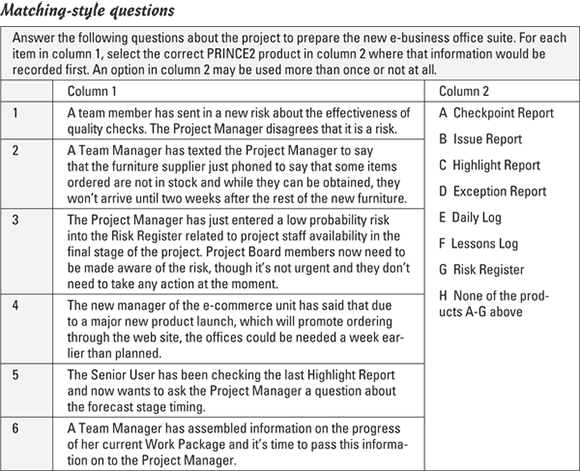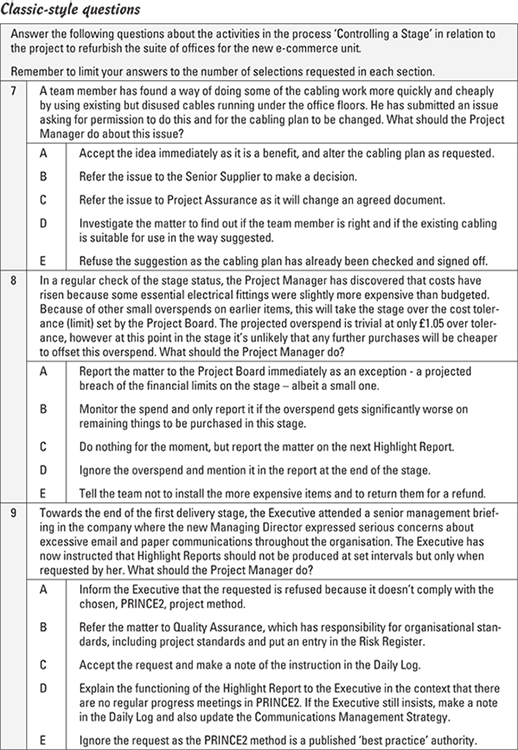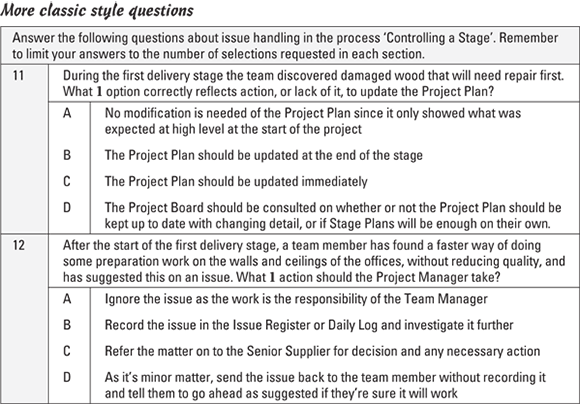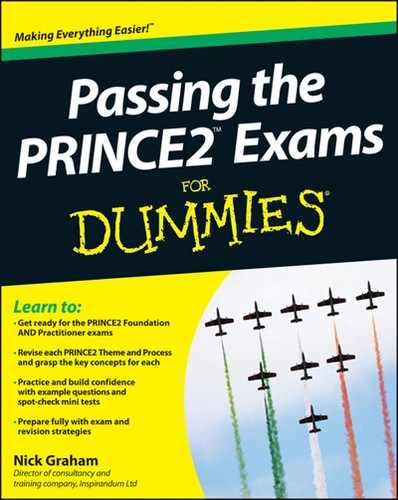Practising With Some Questions
On the following pages you’ll find some questions based on the Controlling a Stage process. You’ll find the answers, with a bit of explanation, on the grey-edged pages at the end of the chapter.
Foundation-level questions
Have a go with these questions to check your knowledge at Foundation level. Try to do the questions in eight minutes or less.
1. What’s the name of the progress report produced by the Project Manager in the process Controlling a Stage?
![]() a) Stage Progress Report
a) Stage Progress Report
![]() b) Highlight Report
b) Highlight Report
![]() c) Checkpoint Report
c) Checkpoint Report
![]() d) Stage Control Report
d) Stage Control Report
2. Progress reports, produced during each stage, are sent to Project Board members. What does the Project Manager check to see whether a copy should be sent to anyone else?
![]() a) Daily Log
a) Daily Log
![]() b) Communications Plan
b) Communications Plan
![]() c) Issue Log
c) Issue Log
![]() d) Communications Management Strategy
d) Communications Management Strategy
3. Why does the Project Manager check the Benefits Review Plan from time to time during a delivery stage?
![]() a) To update it with benefits achieved to date
a) To update it with benefits achieved to date
![]() b) To record who is responsible for specifying benefits
b) To record who is responsible for specifying benefits
![]() c) To enter details of disbenefits identified in the Initiation Stage
c) To enter details of disbenefits identified in the Initiation Stage
![]() d) To see whether any benefits reviews are due and, if so, arrange them
d) To see whether any benefits reviews are due and, if so, arrange them
4. If Project Managers notice that a stage is deviating from its plan, what should they do if control action is within the authority limits delegated by the Project Board?
![]() a) Take corrective action and continue with the stage, adjusting any Work Packages as necessary.
a) Take corrective action and continue with the stage, adjusting any Work Packages as necessary.
![]() b) Record a recommended action and, before taking it, confirm that the board is happy for the delegated allowance to be used in this way.
b) Record a recommended action and, before taking it, confirm that the board is happy for the delegated allowance to be used in this way.
![]() c) Implement the control action but inform the board afterwards of the exact nature of the problem and the action implemented to correct it.
c) Implement the control action but inform the board afterwards of the exact nature of the problem and the action implemented to correct it.
![]() d) Plan a preferred action and get approval from Project Assurance before taking it, to be quite sure that required standards and controls are complied with.
d) Plan a preferred action and get approval from Project Assurance before taking it, to be quite sure that required standards and controls are complied with.
5. When Project Managers receive a progress report from a Team Manager, what should they do?
![]() a) Copy it to the Project Board members for information.
a) Copy it to the Project Board members for information.
![]() b) Pass it to Project Assurance for checking that the data is accurate.
b) Pass it to Project Assurance for checking that the data is accurate.
![]() c) Update the Stage Plan with the progress data.
c) Update the Stage Plan with the progress data.
![]() d) Update the Work Package with the progress data.
d) Update the Work Package with the progress data.
6. If a valid new risk is reported to the Project Manager by a team member, what first action should the Project Manager take?
![]() a) Make an entry in the Risk Register.
a) Make an entry in the Risk Register.
![]() b) Refer the risk to the Project Board, which has ultimate authority for risk.
b) Refer the risk to the Project Board, which has ultimate authority for risk.
![]() c) Write a Risk Report.
c) Write a Risk Report.
![]() d) Refer the risk to the team member’s Team Manager.
d) Refer the risk to the team member’s Team Manager.
7. If the stage is projected to go only very slightly outside stage cost tolerance (the plus and minus amounts set by the Project Board), but this will not affect project cost tolerance, what should the Project Manager do?
![]() a) Escalate the matter to the Project Board immediately.
a) Escalate the matter to the Project Board immediately.
![]() b) Keep the position under regular review, and escalate the matter to the Project Board if it does worsen and threaten the project cost tolerance.
b) Keep the position under regular review, and escalate the matter to the Project Board if it does worsen and threaten the project cost tolerance.
![]() c) Inform the Project Board of the problem in the next Highlight Report (progress report) and include the new cost projection in that report.
c) Inform the Project Board of the problem in the next Highlight Report (progress report) and include the new cost projection in that report.
![]() d) Ignore the matter until the end of the stage and report the minor cost overrun in the End Stage Report.
d) Ignore the matter until the end of the stage and report the minor cost overrun in the End Stage Report.
8. Which statements are a stated purpose of the process Controlling a Stage?
A. Report progress to the Project Board
B. Deal with issues
C. Assign work to be done
D. Create Exception Plan(s) if required
![]() a) A, B and C
a) A, B and C
![]() b) A, B and D
b) A, B and D
![]() c) A, C and D
c) A, C and D
![]() d) B, C and D
d) B, C and D
9. Which PRINCE2 activity does a Project Manager perform before taking action to correct a stage that’s deviated from its plan, or before escalating details of that deviation to the Project Board?
![]() a) Give ad hoc direction
a) Give ad hoc direction
![]() b) Review the stage status
b) Review the stage status
![]() c) Review Work Package status
c) Review Work Package status
![]() d) Report highlights
d) Report highlights
10. When performing the activity ‘Review Work Package status’, the Project Manager updates the Stage Plan. Why is this?
![]() a) To check whether the team has any further Work Packages to do in the stage, in order to start preparing the next Work Package, if there is one, for the team
a) To check whether the team has any further Work Packages to do in the stage, in order to start preparing the next Work Package, if there is one, for the team
![]() b) To update the plan with actuals (time actually taken and money spent) to date, forecasts and adjustments, using progress information from the Team Manager
b) To update the plan with actuals (time actually taken and money spent) to date, forecasts and adjustments, using progress information from the Team Manager
![]() c) To monitor whether the project remains likely to finish within the tolerances (upper and lower limits) set by corporate or programme management
c) To monitor whether the project remains likely to finish within the tolerances (upper and lower limits) set by corporate or programme management
![]() d) To record details of Project Assurance checks carried out on the related Work Package, and the time and cost of performing those checks
d) To record details of Project Assurance checks carried out on the related Work Package, and the time and cost of performing those checks
Practitioner-level questions
Have a go with these Practitioner-level questions against the clock. There’s no additional project scenario for these questions, but do keep in mind the original scenario information set down at the end of Chapter 2.
You should allow 18 minutes for answering these questions, which is because there are 12 to have a go with. In the exam, you’ll have 10 questions in a section and about 15 minutes to answer them. You can look at your PRINCE2 manual to help answer, but try not to look up so much so that you time out. If you’re unclear on how to tackle any of the styles of question, have a look at Chapter 2 where you’ll find some help.




Answers to the Foundation-level questions
1. b. The Highlight Report, produced in the activity ‘Report highlights’.
2. d. In its ‘Reporting’ section, the Communications Management Strategy includes details of the recipients of communications, and such communications include the Highlight Report. The thinking in the manual around the area of communications management and the Project Controls section of the Product Initiation Documentation (PID) remains fuzzy, but in this question the PID wasn’t listed as an option. Be careful: there’s no such thing as a Communications Plan in PRINCE2. Some questions may include plausible-sounding answer options, and you need to be really sharp on what is PRINCE2 and what isn’t, particularly if your organisation uses the non-PRINCE2 term.
3. d. Remember that benefits may come on stream during the project, not just at the end of it and after it. The Benefits Review Plan lists all benefits checks. It’s a plan for checking benefits, as its name suggests, and it isn’t used for recording benefits.
4. a. The whole point of giving delegated authority is that someone can get on with the job within those limits. The Project Manager should get on and manage. You’ll find this reflected in the flow of the activities in the process, and it’s the content of the activity ‘Take corrective action’. The Project Manager may take advice before setting action in train, but that may not be necessary. The other answer options indicate mandatory involvement of others in the handling of every issue, and that just isn’t true.
5. c. The progress information from a team will be fed into the Stage Plan.
6. a. It’s important to ‘capture’ risks, and that’s part of the function of the Risk Register. It’s unlikely that the full information will be available yet – such as on how the risk will be handled – but that doesn’t stop the Project Manager setting up the entry, which can be supplemented with further details as they become available.
7. a. The Project Manager has no discretion to do anything other than refer the matter to the board and to do so without delay. The tolerances represent a specific instruction from the Project Board – the Project Manager’s ‘boss’– that should the projections go outside the stated limits, then the board must be told immediately.
8. a. A no-brainer once you see the purpose statement for the process. [Manual 15.1]. This question is to reinforce the point that you need to be able to recognise the elements of purpose statements, although you don’t need to learn them by heart. This question is kinder than it might first appear if you’re familiar with the stage boundary work, because then you should have picked up on the point that exception planning falls into the Managing a Stage Boundary process, not this one, which is Controlling a Stage.
9. b. This is a check to see ‘where we are now’ before deciding whether action is within the Project Manager’s delegated authority. If you’re not clear on the point, have a look at Figure 7.1 earlier in this chapter.
10. b. The Stage Plan must be kept up to date to serve any useful function in controlling the stage, and so actuals are entered when this information arrives from Team Managers in, or accompanying, Checkpoint Reports. [Manual 15.4.2 last bullet point, P2FD Ch7 Controlling the flow of work to teams – Checking progress on Work Packages]
Answers to the Practitioner-level questions
Matching-style questions
1. E or H. Team members sometimes misunderstand things and can even get carried away in their enthusiasm for spotting risks. The Project Manager is responsible for the Risk Register and can’t be dictated to by over-zealous team members who were watching disaster movies at home the previous evening and who now warn that asteroid collisions may damage the project. The matter may be recorded in the Daily Log together with the Project Manager’s reasons for turning it down, or dealt with by talking to the team member involved and not using any of the documents. The answer E is usually better practice, so that there’s a brief record of what happened if it’s questioned later.
2. B. This looks serious enough for the issue to be formally handled. The first step is to record the detail of the issue, using the Issue Register and an Issue Report. There may or may not be associated risks requiring one or more entries in the Risk Register, but that would come when the issue is thoroughly examined and the question asked where that information would be recorded first.
3. C. The Project Manager can use the Highlight Report to bring things to board members’ notice, including a new risk where the members don’t need to take any action. [Manual A11.2, Key issues and risks, P2FD Ch7 Warning the board of issues and risks]
4. B. Another issue. You might argue that this is a risk, but it would almost certainly be handled as an issue of which one dimension is risk. This question involves some degree of personal judgement, and it’s here to show that sometimes the answer is not always clear cut. The person who set the question probably thinks that the answer is very clear, but other practitioners may disagree – and do in the PRINCE2 trainer events when questions are discussed! In cases like this, choose the answer which seems the ‘most right’ and most in line with the manual.
5. H. There is – quite rightly – no product to cover a minor enquiry from a Senior User, and such an enquiry certainly wouldn’t be an issue. Any board member can lift the phone to talk to the Project Manager about something on a Highlight Report without it being formally recorded. Imagine if every time your boss asked you something, it all had to be written down – completely unnecessary and very impractical.
6. A. The Checkpoint Report is the progress report from a Team Manager to the Project Manager. Don’t confuse this with the Highlight Report, which is the progress report from the Project Manager to the Project Board (that’s the next level up).
Classic-style questions
7. D. The process model shows that the first activity for an inbound issue is ‘Capture and examine issues and risks’, and this action falls into the ‘examine’ part.
8. A. If the Project Manager calculates that the stage will finish outside tolerance and cannot adjust it to bring it back within the limits, then the stage is in exception. The Project Manager has no discretion whatever and must report the exception immediately. It would be pointless to return the items, which are described as ‘essential’, and so not being able to complete the project.
9. D. The Project Manager is bound, ultimately, to do as the Executive instructs, but it makes sense to talk about it first to explain the function of the Highlight Report. Remember that the strategies are not carved in stone and can be modified during the project, although this would more normally happen at a stage boundary.
Sequence question
10. A. You can follow this sequence through by looking at the activities in the process model, but hopefully you answered the question without needing to look at your PRINCE2 manual. Although exception handling is covered in the Progress theme, you really need to be familiar with it to make sense of the Controlling a Stage process, even if you haven’t tackled the Progress theme yet.
More classic-style questions
11. B. The ‘official’ and so correct exam answer is that the Project Plan will be updated on the stage boundary, not in the process Controlling a Stage, which is the subject of this section. In practice, that’s likely to be different, but this question is partly to emphasise the point that the exams are based on PRINCE2 as set down in the manual.
12. B. The Project Manager should record the issue one way or the other (register or log) and then check it out. It shouldn’t be ignored or passed to a Project Board member. Neither should a Project Manager send it straight back and tell the team member to get on with it. What if the team member was wrong? At the very least, the Project Manager would be likely to talk to the Team Manager about the issue, as part of the ‘examine’ function of the activity ‘Capture and examine issues and risks’.

 The questions in this chapter are examples, and some are aimed at bringing particular points of exam strategy to your attention. Before your exam, you should also have a go with the official practice papers available from your training provider or from the exam authority. For the Foundation, do the official sample paper after you’ve finished learning the method, or when you’ve nearly finished. That’s because, unlike in this book, the questions are not grouped by subject but rather are in random order.
The questions in this chapter are examples, and some are aimed at bringing particular points of exam strategy to your attention. Before your exam, you should also have a go with the official practice papers available from your training provider or from the exam authority. For the Foundation, do the official sample paper after you’ve finished learning the method, or when you’ve nearly finished. That’s because, unlike in this book, the questions are not grouped by subject but rather are in random order.